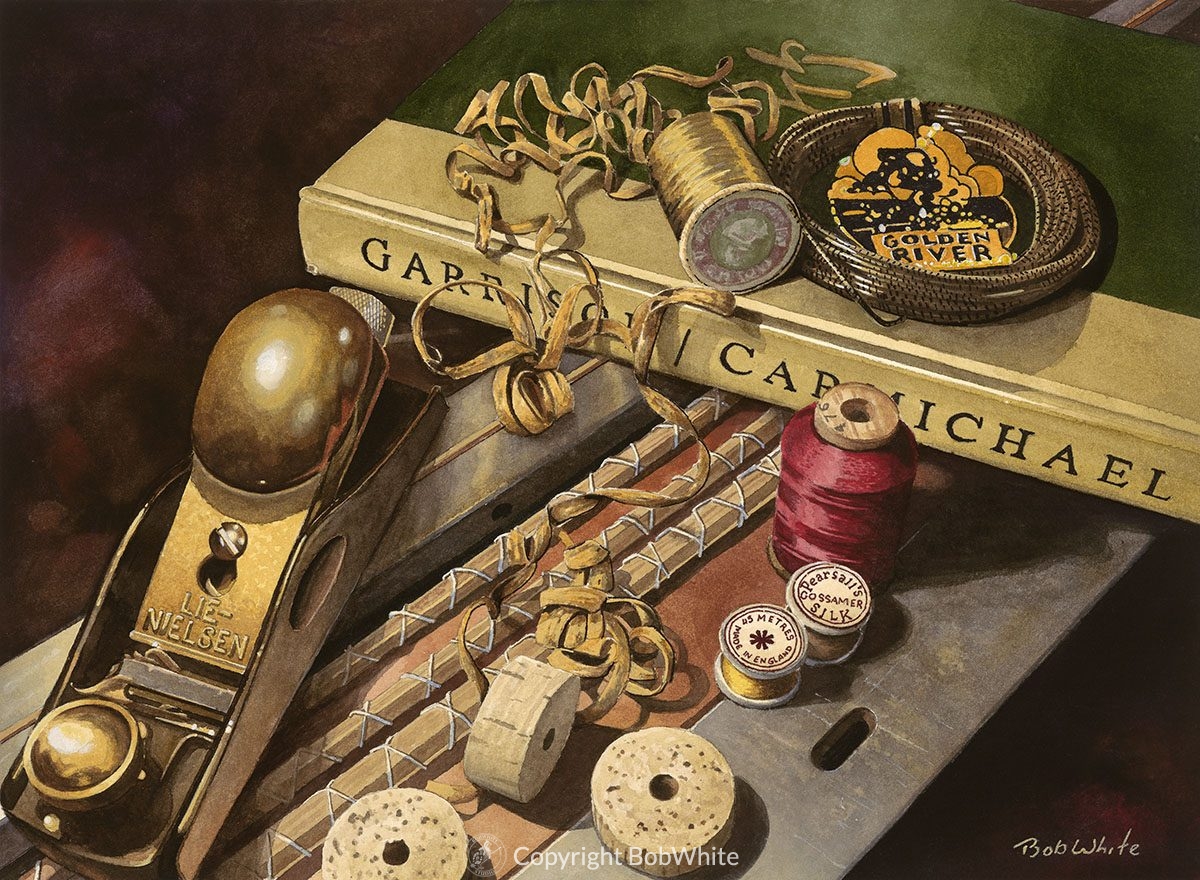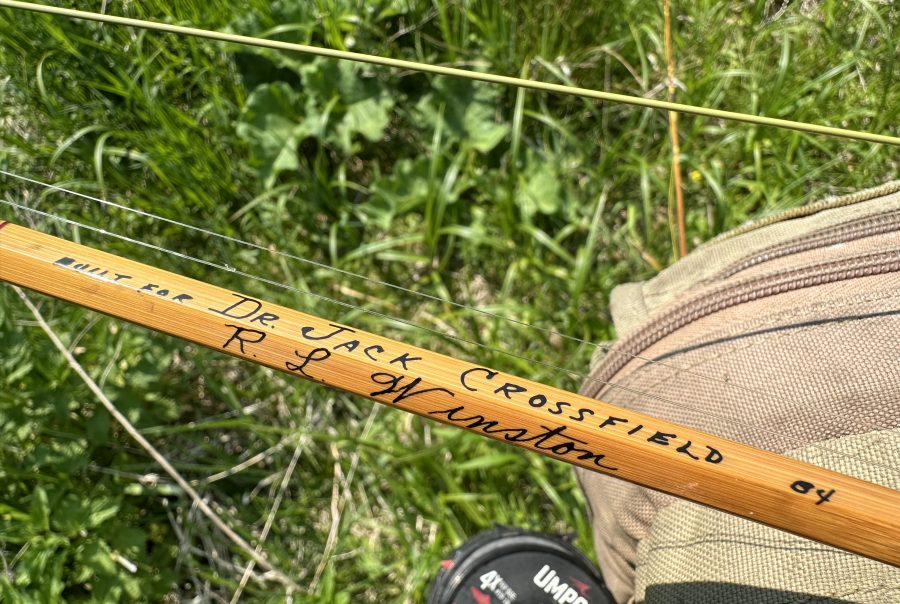
A good story cannot be devised; it has to be distilled.
~ Raymond Chandler
Bamboo fly rods, like most of the important things in my life, seem to happen to me when I least expect them.
“Dave’s here,” Lisa said as she looked up from her desk. “He has an arm load of rod tubes. You might be going fishing this afternoon.”
I like friends who bring their dogs when they come to visit, and Dave’s golden retriever was already tearing it up with our bird dogs. Dave stood in the back yard, clutching several rod tubes in his hands and shaking his head while he watched the shenanigans. I called to him from the open window, and he answered, “I wish that I had that much energy,” he said. And then, “I’ve got something to show you.”
Lisa poured coffee while Dave pulled cloth rod sheaths from their tubes and handed one of them to me. The smell of just-set spar varnish permeated the room. “What d’ya think?”
“It’s beautiful,” I said, pulling the bamboo butt section out and admiring the perfect finish. “You made this?”
“Let’s go cast them,” he suggested, as he patted the bulge in his jacket pocket that could only be a fly reel.
I’d cast a few cane rods over the years, but I’d always admired them from a distance; I’d never owned a bamboo rod, and hadn’t ever fished with one. While I was raised to appreciate all things hand-made, and have a high regard for their beauty and the artistry it takes to build them, it just didn’t seem practical for me to carry an heirloom rod when guiding.
A guide’s rod is often used as a back-up should the client’s break. If the client chose to fish dry flies, I’d rig mine with a nymph so we could try different flies and techniques by just switching rods. In addition, while the fisherman probed the water with my rod, I had a few extra minutes to quietly unravel the inevitable wind knots in their leader, tie on fresh tippet, attach a different fly, and sharpen the hook.
Breaking any rod, even with an industry discount, is heartbreaking. The loss of a bamboo rod that’s been built by a friend would almost be enough to make me give up guiding and buy a jet ski.
“This is nice,” I said as my loop tailed and collapsed upon itself.
“You don’t throw bamboo very often,” Dave said kindly (it was more of a statement than a question). “They’re much softer and slower than what you’re used to. Don’t try to over-power it, there… that’s it, much better.”
“Hey, this is really nice,” I said, as a long, tight, buttery loop straightened out and fell to the lawn.
“Do you want one?” He asked.
“How much would it cost us?” I inquired with a gulp. We live close to the edge, but even though we could never afford it, I knew that Lisa would agree to whatever the price because she loves us both. I married wisely… and that good fortune comes with a lot of responsibility.
“How about if you paint me a watercolor in exchange for a rod?” He asked. Dave already knew my answer, and continued. “Let’s try a couple of different tapers.” A few months later Dave stopped by with my rod, and I started a collection.
The watercolor that illustrates this essay is titled “Bamboo”, and it shows Dave’s workbench and the makings of my first bamboo rod.
A trade is good when both parties feel they’ve come out ahead. This is particularly true with artists, when each produces something the other admires but is unable to make.
Sometimes what one has to offer a friend in trade is less than obvious.
“Are you going to fish with Jay today?” Lisa asked, as she turned from her work and looked toward the driveway.
“Maybe,” I said. I was working desperately on an illustration as I watched Jay turn his setter, Libby, loose to play with our Mac and Luke. Once the dogs were introduced, he pulled a short, green rod tube out of his car, and walked slowly, almost thoughtfully, toward the studio.
His face was blank when he walked into the room and silently handed me the rod tube. “What have you been up to?” I asked in an effort to discern how deeply in debt we were about to go.
There was no reply, as I opened the rod tube in a trance. The now familiar aroma of fresh spar varnish wafted throughout the studio. “It’s my second one,” he said. “What d’ya think?”
“It’s beautiful,” I replied. “But, I’m hardly the one to ask. How come you didn’t put your name on it?”
“It’s only my second rod,” he replied. “They’ll get better.”
Now that I owned a bamboo rod, I fancied myself a collector, and that implied owning more than one. “I’d love to have one of your rods,” I said. “How much are they?”
“Not a thing.”Jay answered. “This is for you… but you have to go with me and fish it today.”
The first two bamboo rods I came by were both made for me by close friends. The next two came to me from an old friend who didn’t make them, but surely knows how to use them.
I went to Alaska in the spring of 1984 to become a fishing guide. It was during that first summer I met Jack Crossfield. Like the heroes of my youth, Jack was bigger than life; well over six feet tall, with hands the size of small hams. Jack’s physical presence was eclipsed only by his experiences. He’d hunted and fished all over the world. He’d shot game in Africa, fished from Alaska to Argentina, and was a champion at the Golden Gate Casting Club back in the 50’s and 60’s. He knew double guns, bamboo rods, bird dogs, and whiskey. He had a gravely voice that was perfect to tell a story, particularly if there was an ironic twist to it’s end. His eyes were bright and quick. His nature was generous. He didn’t bullshit because he didn’t have to, and if you were lucky enough to earn his respect and friendship, you could take it to the bank. He was my best man when Lisa and I married at the lodge one summer.
Jack was what I think of as a “man’s man”; Teddy Roosevelt, Jack London, and Zane Grey all rolled into one. I can honestly say that our time on the water together is one of the things I missed most about my hiatus from Alaska.
After a couple of seasons of not fishing with Jack, I came to the realization that we might not see each other again. Life’s funny that way; the routines that we take for granted suddenly change and leave us with just our memories. With that realization it occurred to me just how much I’d like to have a set of Jack’s rods, not so much to fish, as to hold. It didn’t matter to me if they were graphite or fiberglass. As it turned out, when I asked Jack if he might consider such an arrangement, he agreed, and sent me a set of his bamboo rods; two classic, fluted, Winston rods, made for him by Doug Merrick.
Jack’s been gone for over two decades and while I’ve fished with these rods on the little Mill Stream behind the studio, and have caught some nice little brookies with them, I’d never really fished them seriously. While I banged around the studio, gathering gear for a recent fishing trip with friends to the Minnesota Driftless, Lisa looked up from her desk and asked what rods I planned to take, and then before I could answer, she suggested I take Jack’s rods. “He’d like that,” she said.
The rods got nods of approval from my buddies, bamboo aficionados all, and they cast like a dream. Fish were caught, but to be honest it’s not the fish that I remember… it’s my friend, Jack.
Most of the cane rods in my collection have been bartered for, some were gifted, and others found. One was a combination of all three.
Lisa and I were in South Carolina to hunt and visit with friends when I came upon what many bamboo rod collectors could only dream about. We’d been invited to hunt turkeys on the property of mutual friends, and long before dawn joined them at their historic plantation house.
Early breakfast consisted of strong coffee and biscuits sweetened with molasses and talk of turkeys. Billy would guide me, and Lanny would guide Lisa. Carrington and Mary would stay behind and use the morning to prepare an enormous hunter’s breakfast for our triumphant return. We felt fortunate as we left and went our separate ways into the cold and damp false-dawn.
During those grey morning hours, we heard a lot birds call, both hens and toms. We saw a few, and maneuvered into position for shots that never materialized; it was a typical turkey hunt. Most importantly we didn’t hear the ladies shoot, which meant that breakfast would be amicable.
The after-hunt breakfast was enough to drop any cardiologist’s jaw and in the warmth near the fireplace I had a minor epiphany. While I gently blew over my coffee, I asked our host, “Carrington, have you ever made whiskey?”
Carrington hesitated for just an instant, not really long enough to incriminate himself, but certainly long enough to judge a man. Mary looked around the room nervously and went to the cupboard for more mayhaw jelly even thought the dish next to the biscuit platter was still half full.
Though we’d known each other only a short time, it seemed to me that he’d judged me to be a trustworthy friend, and most importantly; not an ATF agent. He looked around the room conspiratorially, and then asked with a twinkle in his eyes, “Would you like to see my still?”
Mid-morning found us in the old log barn. Carrington was up in the loft, and I was next in line, handing pots and coils of tubing down to Billy, who passed them off to Lisa and Lanny, who deposited them on the lawn where Mary instructed us all in the proper construction of a still.
As the last part was handed to me, a small aluminum tube rattled across the rafters, and I immediately recognized it for what it was; a rod tube. “What’s that, Carrington?” I asked.
“Oh, that old thing, it’s my father’s old fly pole.”
“Mind if I take a look?”
“Of course not,” he said. “I haven’t seen the old Payne in years. ‘Forgot that it was even up here.”
I pulled the pale green cloth bag from the dusty tube and read the tag.
E.F. Payne Rod Co., Inc.
Highland Mills, N. Y.
# 43329
7′ – 6″ Feet
3 3/8 Ounces
Parabolic
“Wow.” I said.
“It’s in pretty tough shape,” he replied.
“You might want to have this rod restored,” I suggested. “It might be worth something.”
“Naw, I’ll never get around to it,” he said. “If you like it, you can have it.”
“Wow.” I said again. “I’d love to have it; but only if you’ll let me send you a painting for it. And it’s important that you understand that I’ll have it restored and fish with it.”
“My father would like that,” Carrington said with a wink. “Now let me show you how to set up a whiskey still!”
Once assembled, Carrington eyed the still approvingly, and now that I was in his confidence, let me know that he’d be more than happy to lend it to me… strictly for my private use. “You’ll need a lot of time and fresh, cold water,” he told me while he instructed me in the process of distilling whiskey. “Water was always the tough thing around here… that is until I blew open the spring.”
“Now… that was a day to remember!” Mary chimed in. “Something I’ll never forget.”
“We had this piddly little spring out back,” Carrington continued. “It wasn’t much of anything. Still, some of the old folks ’round here remembered it as more. They said that the damned Yankees mucked it up with their horses.
After it’d filled in, a big old cottonwood, we called it the ‘General Sherman’, decided to grow plumb smack in the middle of it,” he said, with a faraway look in his eyes. “I figured that if I blew out the tree… well, we’d have water enough. So, I went to town for some dynamite.”
“They wouldn’t sell him just half a box,” Mary added. “He packed that tree’s roots full of the stuff. Until there wasn’t half a box of dynamite left.”
“Then, I figured, what in tarnation are we going to do with half a box of that stuff around here anyway? I didn’t want it around the place, so I made room for the rest of it.”
“I ran back to the house,” Mary said.
“And, I hid behind the hill and touched her off.”
“Every window in the house shook, some broke!”
“And I did a somersault that landed me right on my backside… just in time to see the old ‘General’ lifted off the ground and shot into the sky like some kind of Sputnik rocket!”
“People heard it from all ’round.”
“That damned tree came down on the other side of the creek like a cat thrown from a second-story window; roots first. It stuck itself in the mud, and that’s where it still stands, healthy as can be… to this very day!”
As the number of friends who build fine cane rods grows, so does my collection. I still don’t cast them very well, and I rarely fish with them… but that’s really immaterial to me. What’s important is that I see them every day, because they remind me about the most important things in life; my friends, family, and the experiences that we share.






